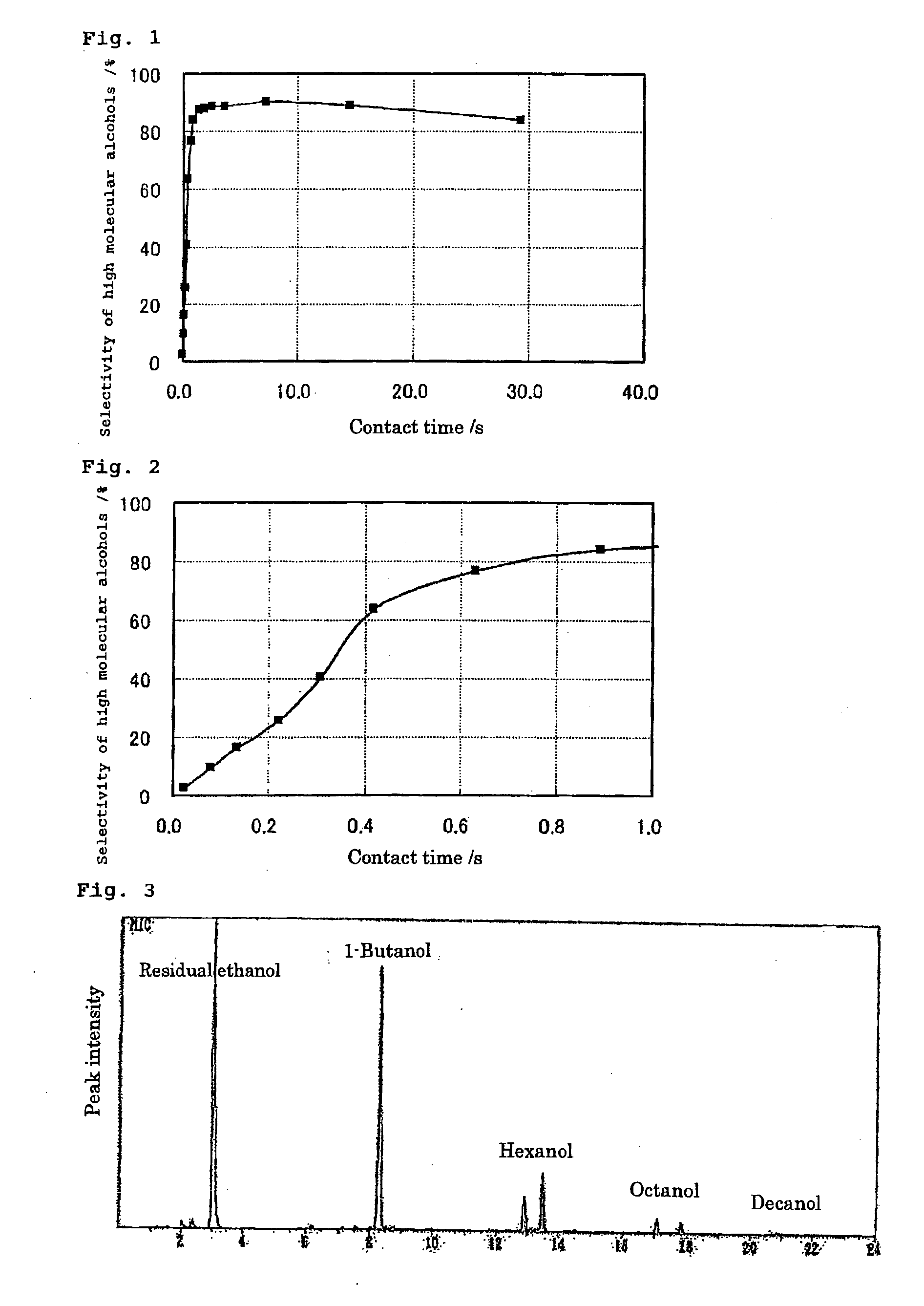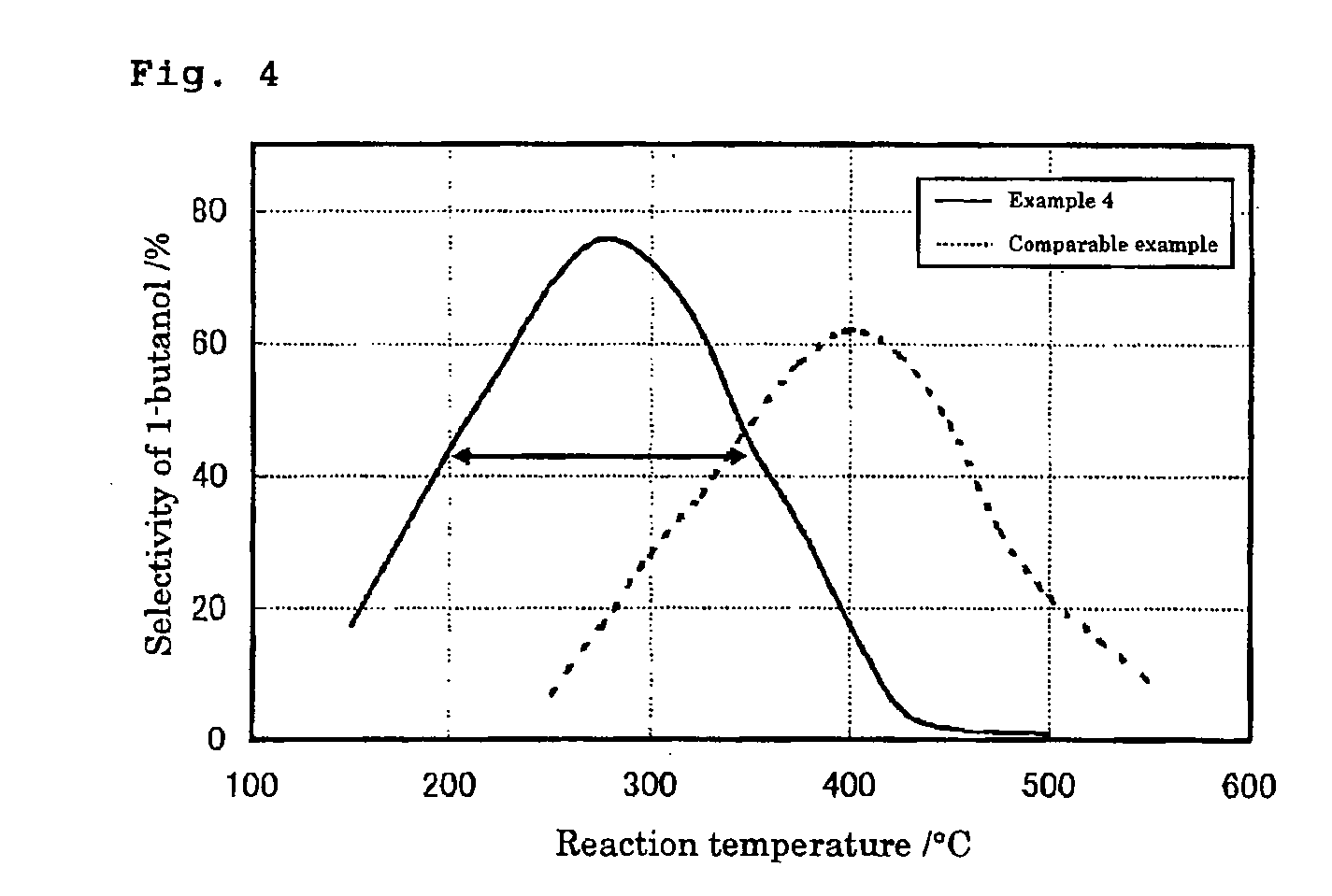Method of Synthesizing Higher-Molecular Alcohol
a high molecular alcohol and ethanol technology, applied in the field of high molecular alcohol production from ethanol, can solve the problems of unpreferable oxo method in view of environmental conservation, unfavorable oxo method, and poor profitability, and achieve the effect of efficient collection through clean processes
- Summary
- Abstract
- Description
- Claims
- Application Information
AI Technical Summary
Benefits of technology
Problems solved by technology
Method used
Image
Examples
example 1
Preparation of Catalyst
[0044] A solution prepared by dissolving 225.2 g of calcium nitrate: Ca(NO3)2.4H2O in 5.0 liters of distilled water and a solution prepared by dissolving 78.87 g of ammonium phosphate: (NH4)2HPO4 in 3.0 liters of distilled water were added dropwise to aqueous ammonia of which pH had been adjusted to 9 to 11 under a nitrogen atmosphere, and the resultant mixture was stirred for one day. Subsequently, the mixture was filtrated, washed with water, and dried to obtain a powder. Ion-exchange water was added to the obtained powder, and the resultant mixture was crushed for 48 hours with a ball mill. The slip thus obtained was matured and dried at 140° C. in an oven. The resultant powder was calcinated in the air at 600° C. for 2 hours to obtain a powdery catalytic composition whose Ca / P molar ratio was 1.64.
example 2
Evaluation of Catalytic Property
[0045] A fixed bed gas flow catalytic reactor was used as a reactor. The powdery catalyst was formed into tablets of 14 to 26 mesh. The tablets were filled in a reaction tube in an amount in accordance with the contact time, and a thermal dehydration treatment was conducted as a pretreatment under carrier gas (1% Ar / He-based; flow 112 ml / min) atmosphere, at 500° C. for 30 minutes. After the pretreatment, the tablets were reacted at normal pressure under the conditions of ethanol concentration of 16 vol %, carrier gas flow 112 ml / min (total flow 134 ml / min).
[0046] In case of the high molecular alcohol synthesis experiment, the reaction temperature was fixed at 300° C., and the contact time was in a range of 0.02 to 29.4 seconds. In the optimization experiment of 1-butanol synthesis conditions, the contact time was fixed at 1.0 second, the ethanol concentration was 8.1%, and the reaction temperature was in a range of 150 to 500° C.
[0047] A gas chroma...
example 3
Example of Analysis by Gas Chromatography Mass Spectrometer (GC-MS)
[0056] The ethanol conversion experiment was conducted with the use of a hydroxyapatite catalyst at an ethanol concentration of 16%, for a contact time of 1.78 seconds and at a reaction temperature of 300° C., and an analysis was conducted with GC-MS. The results are shown in FIG. 3.
[0057] The peaks of 1-butanol, hexanol (2 types: iso and normal), octanol (2 types: iso and normal), and decanol (3 types: iso and normal) can be observed at the retention times of 8.5 minutes, 13 to 14 minutes, 17 to 18 minutes, and 20 to 22 minutes, respectively.
[0058] It can be seen from this result that high molecular alcohols having 4 or more and an even number of carbon atoms are synthesized selectively.
PUM
| Property | Measurement | Unit |
|---|---|---|
| temperature | aaaaa | aaaaa |
| molar ratio | aaaaa | aaaaa |
| molar ratio | aaaaa | aaaaa |
Abstract
Description
Claims
Application Information
 Login to View More
Login to View More - R&D
- Intellectual Property
- Life Sciences
- Materials
- Tech Scout
- Unparalleled Data Quality
- Higher Quality Content
- 60% Fewer Hallucinations
Browse by: Latest US Patents, China's latest patents, Technical Efficacy Thesaurus, Application Domain, Technology Topic, Popular Technical Reports.
© 2025 PatSnap. All rights reserved.Legal|Privacy policy|Modern Slavery Act Transparency Statement|Sitemap|About US| Contact US: help@patsnap.com


